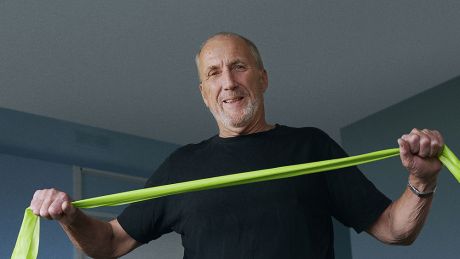How To Use Exercise To Help A Long-Term Health Condition
Start with the We Are Undefeatable website

Exercise is good for you and often you’ll feel on top of the world after you’ve worked up a sweat. But even the most ardent exerciser will admit that sometimes the spirit isn’t willing, and the flesh is weak and fancies a sit-down.
Now imagine you’re one of the estimated 43% of people in England living with a long-term health condition. Conditions like asthma, arthritis, type 1 diabetes, Parkinson’s and dementia may make a preferred type of exercise untenable, and the disruption to someone’s life may leave them lacking the motivation to stay active.
The We Are Undefeatable campaign aims to help those people find an activity that’s right for them so they can reap the benefits in both their general physical and mental health. “It empowers and enables people who are living with long-term conditions, but in a way that works with their condition rather than against it,” says Dr Zoe Williams, who’s helping to spread the word about the campaign, which is entering its second year.
“People with long-term conditions say it's the first time they've seen people who have their condition represented in a really positive way, being physically active in a big campaign like this,” says Williams. “I think that's really encouraging and motivating for people.”
What’s perhaps surprising is that the benefits can extend to addressing the physical impact of a condition. “For all long-term conditions, exercise, movement or physical activity should form part of the treatment,” says Williams. “It can seem counterintuitive, for instance if somebody has joint pain from arthritis, but if they are able to build up gradually and do something that strengthens the muscles that support the joints, it’s one of the best things to alleviate the symptoms.”
See related
- Help Someone With A Long-Term Health Condition – Tell Them About This Campaign
- “Focus On What You Can Do, Not What You Can’t”: How To Get Into Exercise If You Have A Disability
- Give Your Joints A Break With This Low-Impact Workout From Studio FLY LDN
Finding something that works with the individual condition and starting small is something that Williams emphasises but, she says, “the key thing here is, anything more than what you did yesterday counts”. Williams often recommends sit-stands to patients in clinics, simply standing up out of a chair, sitting down again and repeating. “If people can do that ten times, three times a day, that is enough to really start to feel some benefit and get some strength in the legs. And if you're watching TV, use the adverts coming on as a reminder.”
Of course, sit-stands won’t be appropriate for many people, but you’ll find plenty of specific advice for a wide range of conditions on the website, coupled with inspiring stories of people who are in the same boat and are benefiting from the release of exercise.
Get the Coach Newsletter
Sign up for workout ideas, training advice, reviews of the latest gear and more.
“There's loads of advice on there around COVID-19,” says Williams, “and ideas for people who might be self-isolating or shielding… things you can do without leaving the home, and ways to connect with other people who might be going through what you're going through and support for maintaining emotional wellbeing as well.
“Plus, the website has got this thing I really like called Five In Five. It’s a whole range of exercises, and you choose which five suit you best and do each exercise for one minute. That’s a five-minute workout completely bespoke to you.”

Jonathan Shannon was the editor of the Coach website from 2016 to 2024, developing a wide-ranging experience of health and fitness. Jonathan took up running while editing Coach and used the training plans on the site to run a sub-40min 10K, 1hr 28min half marathon and 3hr 6min marathon. He’s an advocate of cycling to work and is Coach’s e-bike reviewer, and not just because he lives up a bit of a hill. He also reviews fitness trackers and other workout gear.
